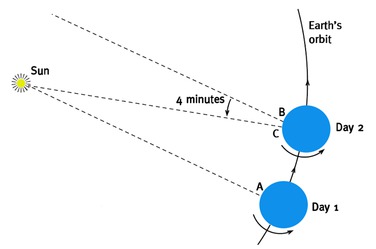Look at the display on the right and notice that the sun is on the meridian—the imaginary line that runs from due south to straight overhead and on to the northern horizon. Daylight is turned off so we can see the stars as well as the sun. Some stars near the meridian are labeled.
Click the S button in the Time and Date display to advance the time by one sidereal day. The stars appear not to have moved—they have made a complete circle around the North Star and returned to their original position. But notice that the sun is now about one degree to the east of its position the day before and is not quite on the meridian.
Notice also that the date has advanced by one day but the time has decreased by four minutes.
Now change the time step to four minutes in the Time Flow Rate display and then click the S button in the Time and Date display to step forward four minutes and complete one solar day. The sun is now back in the same place in the sky, but the stars have shifted slightly to the west.
This four-minute period is the difference between a solar and a sidereal day—the difference between one rotation of the Earth relative to the sun and one rotation relative to the stars.
A sidereal day is one rotation of Earth relative to the stars, not to the sun, and the difference explains why the stars rise and set four minutes earlier each day.
